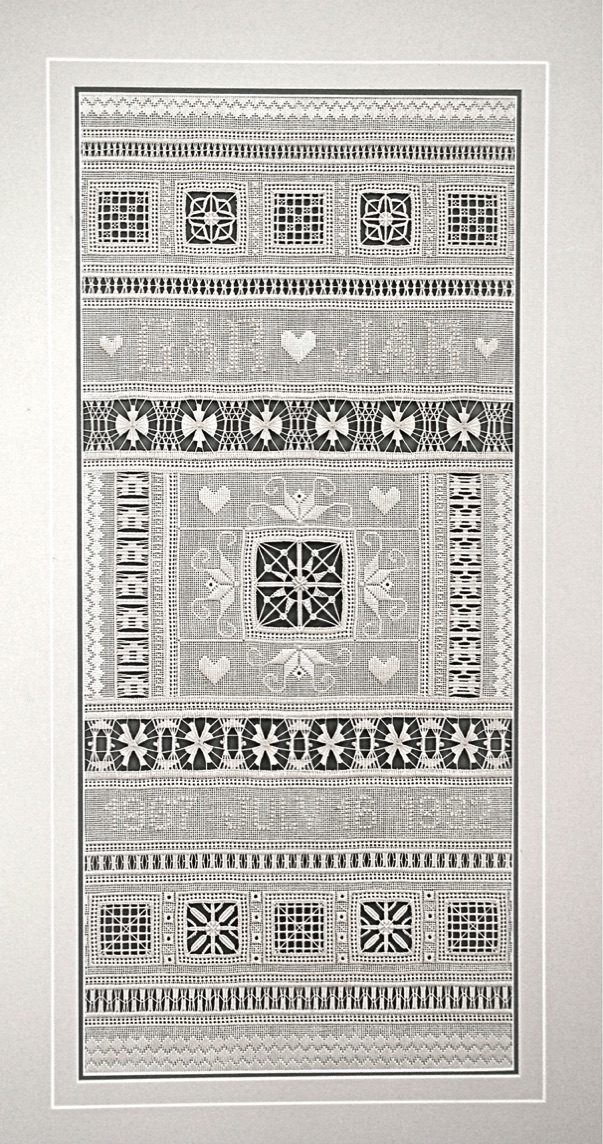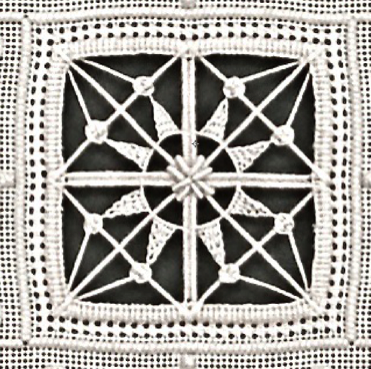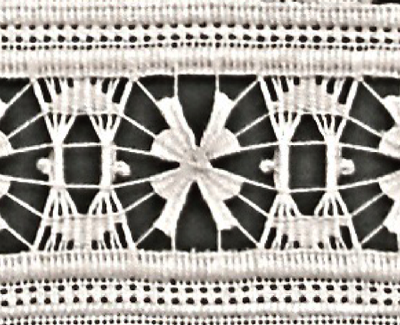
My Personal Favorites
Here is a small collection of my favorite work:
I am changing my list from five.
I will tell the story of each as I post it. For several, I have told the stories many times, others this is the first time.
This is my Drawn Thread Sampler
Drawn Thread Sampler
Drawn Thread Sampler, Part 1 My History with Pearl Cotton
Poor Pearl Cotton, a thread I have loved forever. Is it possibly the most maligned thread in the needlepoint world? For beginners only, why would anybody choose pearl cotton when there are so many beautiful threads on today's market? No advanced stitcher chooses pearl cotton, and so forth.
I love pearl cotton! I have loved pearl cotton for years and years and here's why:
To me, I see pearl cotton and I think of all those whitework techniquest that I can do: on the easier end, all those beautiful pulled thread patterns, on the harder end, all those beautiful cutwork patterns that can try one's soul.
Yes, there are other threads you can use: cordonnet and coton a broder, but I prefer pearl cotton. Cordonnet has such a tight twist, coton a broder can look mushy; pearl cotton for me hits the right note.


Drawn Thread Sampler
Drawn Thread Sampler, Part 2 My History with Whitework
DH and I spent a total of just about 12 years in London, always a stone's throw from the V&A, and thus began my romance with whitework. The V&A then had a study room filled with a feast of samplers and I spent an inordinate amount of time trying to figure out how to adapt the cutwork I found on them to my own needlework.
I would sit at a table in the V&A with a sampler in front of me, and I would make drawings, then go home and with Elizabeth Prickett's book on one side of me, Onone Cave’s book on the other and a doodle in front of me, I would try to figure out how to do the cutwork. Double double, toil and trouble, I figured out a way, and Drawn Thread Sampler is my attempt at some of these techniques.
I am a great believer in easy. If I can accomplish what I wish with an easy stitch, why would I choose a difficult one? Drawn Thread Sampler includes the only genuinely difficult techniques I know.
Drawn Thread Sampler
Drawn Thread Sampler, Part 3 The Medium-Difficult and the Most Difficult
As you look at Drawn Thread Sampler, you will see that it is a collection of whitework techniques, some easier than others, some the most difficult I know. What makes them difficult? Tension of course. If you have been stitching for some time, you will know that the game is tension.
In needlework technique, tension is the whole game, and so it is with cutwork. It takes time.
If you have had any experience with drawn thread techniques, you will recognize mounting threads, wrapping them and needleweaving around them. In addition, gazillions of Coral Knots on the two horizontal bands, Bullion Knots and of course Buttonhole Stitch.
So which is the most difficult? A form of Buttonhole Stitch called Venetian Cloth Stitch: it is the rays of the sun, so to speak, on the center square. I treasure this sampler because it shows my early attempts at Venetian Cloth Stitch when it was super hard for me. I can't say it ever got easy, but I got a lot better at it after years of practice.
See the little nubs on the lower close up? Most people don't like picots, most don't like Bullion Knots. Put them together and you get Bullion Picots, not the easiest thing I know how to do.
And so on. It takes practice, it takes good tension. None of it is super easy.
Drawn Thread Sampler
Drawn Thread Sampler, Part 4 Stories About Teaching Drawn Thread Sampler
In the old days when I was more industrious than I am now I applied Drawn Thread Sampler to EGA's National Seminar in Williamsburg and I had a class of 24 people.
In my long teaching career, this was the only project I billed as 'Advanced'. The class was a full four days long. The pre-class work was 50 hours, or so my students told me. The first day of class we cut threads which can be daunting in a classroom situation -- what if you cut wrong? The second day the easier techniques, the third day the crushingly difficult ones that I struggled with in those days.
I woke up on the third morning of class and willed my hands to work well. I had a daunting task: I had to make the hardest techniques I knew work as if they were easy. Nothing is worse than showing my struggles in front of students, for it puts them off. The students think, if the teacher struggles, I'll never be able to do it. So I demonstrated these techniques for 6 hours and at the end of the day I was bushed.
A friend of mine was in my class. At the end I said to her, let's go somewhere, I'm absolutely bushed! She said, why? You had an easy day of it! And I thought, Yay! I succeeded!
I taught Drawn Thread Sampler a handful of times, at Callaway, at regional seminars and a few times at chapters, then I retired it and moved on.
Years later, after I had retired from travel teaching, Jane Ellen Balzuweit taught it for Shining Needle Society.
Drawn Thread Sampler
Drawn Thread Sampler, Part 5 Returning to Pearl Cotton
As I said, Poor Pearl Cotton, its modern fate of being so maligned is sad. It is seen as such a beginner's thread, yet I always think: open a kit of mine and if you see a lot of pearl cotton, you will find some difficult techniques ahead.
And as I said, Drawn Thread Sampler is technically my most difficult sampler. Open its kit, here's what you will find: a piece of ground fabric and 10 balls of pearl cotton, 5 of #8 pearl cotton, 5 of #12 pearl cotton. Yes, that's it.
Drawn Thread Sampler
Drawn Thread Sampler, Part 6 Two Last Stories: Here's the First.
Fast forward in my travel teaching career to years after I first taught Drawn Thread Sampler, I had settled in to being comfortable with basic squares of cutwork: cutting, wrapping and executing the various filling stitches, and for a long time I knew that students new to the techniques might struggle, but if they practiced a while, they could become proficient at it. It might never be easy, but practice helps the comfort zone.
One of the difficult parts is mounting circles. You cut the threads, wrap or needleweave the bars, and then you mount circles by stabbling sideways through each bar with a sharp needle and thread. This isn't difficult to do per se, but getting the circle round and evenly in the center is challenging. You have to eyeball it. Practice is the name of the game.
I don't remember where I was teaching, but my class had reached the point of mounting circles. I demonstrated the technique, the told the students to have a go at it. Here's what I recognized: I had told them the wrong size. I let them struggle for a couple of hours, then right before lunch I told them: there's good news and bad news. The good news is, you are all making round circles! Good for you! The bad news is, I told you the wrong size, cut them out and do it again.
I had mutiny! The class was full of some of my favorite people and they were so mad at me! But, said I (and rightly so), the only way you are going to master this is practice and now you have an excuse for a little extra practice. I don't think they ever forgave me, but they got over it and we moved on to harder techniques.
Drawn Thread Sampler
Drawn Thread Sampler, Part 7 Two Last Stories: Here's the Second One
Toward the end of my travel teaching career, I taught a class for ANG which had a Cutwork Square and therefore the kit had two balls of pearl cotton.
I had a very arrogant student and as he opened his kit and looked at the pearl cotton, he raised his hand and asked me, 'tell me, Gay Ann, do you think that pearl cotton is the polyester of needlepoint threads?'
I decided to answer gently, I said 'there is a place of all threads and pearl cotton has its uses. In a day or so you will find out just what it takes pearl cotton to do.'
He was an average stitcher and a couple of days into the class, he struggled. He really struggled. Predictably. Everybody does the first time out. It all just takes practice.
I will end by saying again, if you open a kit of mine and see pearl cotton, don't count on the project being for beginners. chances are, you are starting a project that has some difficult parts.
